#Gibson Super 400
Explore tagged Tumblr posts
Text

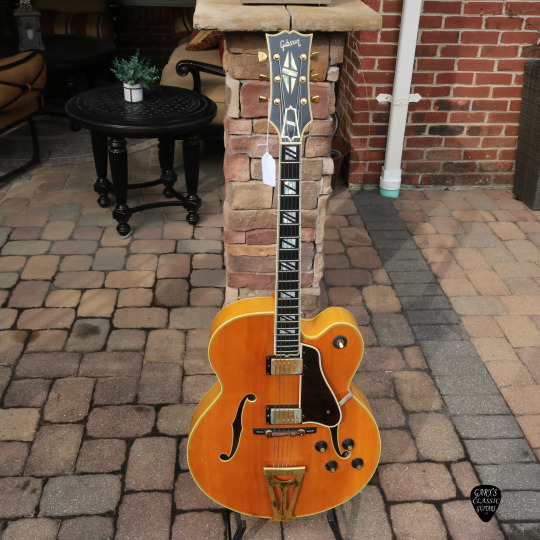
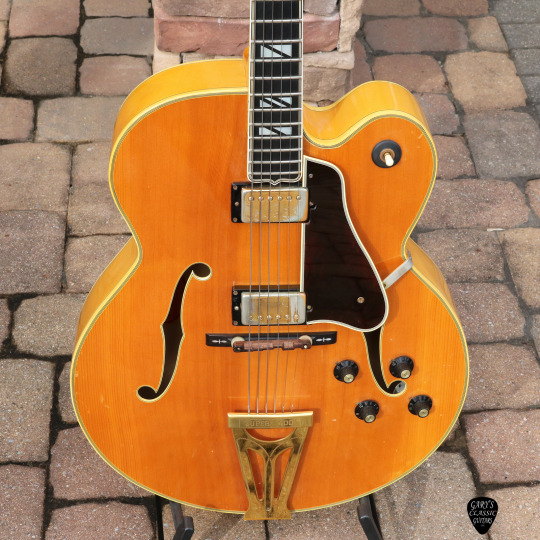

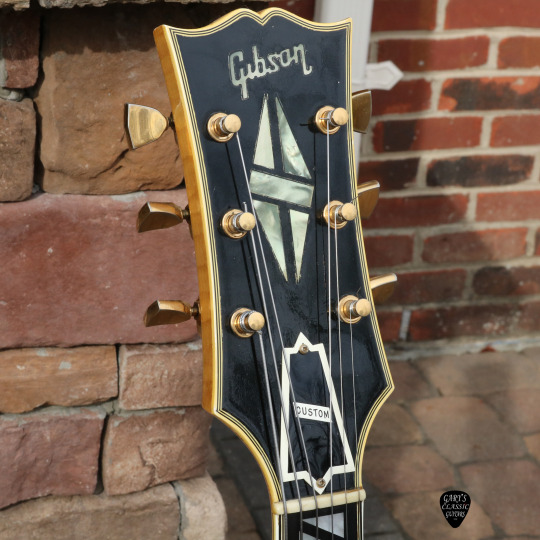

Magnificent 1970 Gibson Super 400
19 notes
·
View notes
Text
🎸Scotty Moore's guitars⚡

Scotty Moore with his '54 Gibson L-5 CESN, originally purchased by him in July 7, 1955.
youtube
Besides how it was recording with Elvis and other amazing stories such as one incident involving the three rock and roll pioneers (Elvis, Bill and Scotty) and Bill Black's bass later owned by Paul McCartney, on this interview Scotty talks a bit about his early music instruments' history, such as amplifiers and guitars. He mentions the✨Gibson L-5 CES✨, which we'll know about a bit more from now on:
Much of the RCA 50's recordings of Elvis Presley feature the sound of Scotty Moore's L-5.

Scotty (with Gibson L-5), D.J. Fontana (drums), Elvis (with 1951 Epiphone FT-79*) and Bill Black (bass) in Texarkana, AR, 1955. * The 1951 Epiphone Elvis is playing belonged to Charline Arthur, a female American singer of boogie-woogie, blues, and early rockabilly.
Scotty traded his ES-295 in on July 7, 1955 at the O.K. Houck Piano Co. located on 121 Union Avenue in Memphis, for this Gibson L5 "mainly because the workmanship was just so much better in the L5, of course it cost more too" ($565.00).
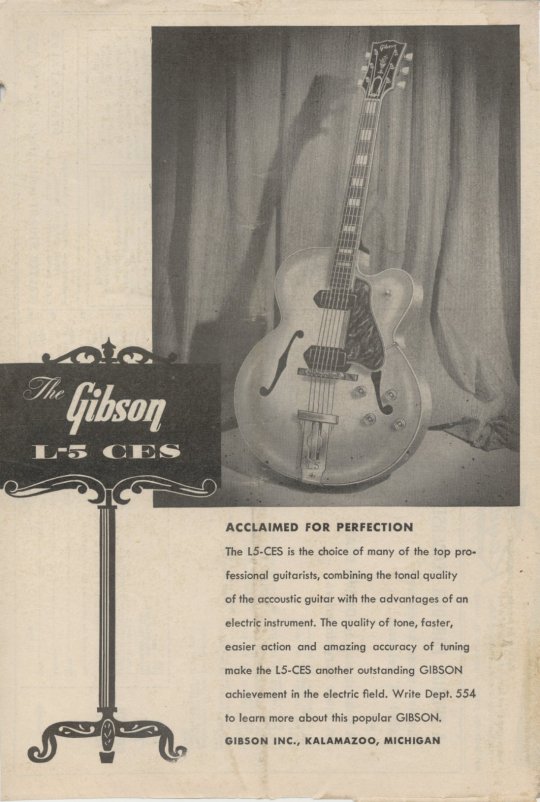

L5 CES ad, and Scotty's original receipt for the 1954 L5 CESN.
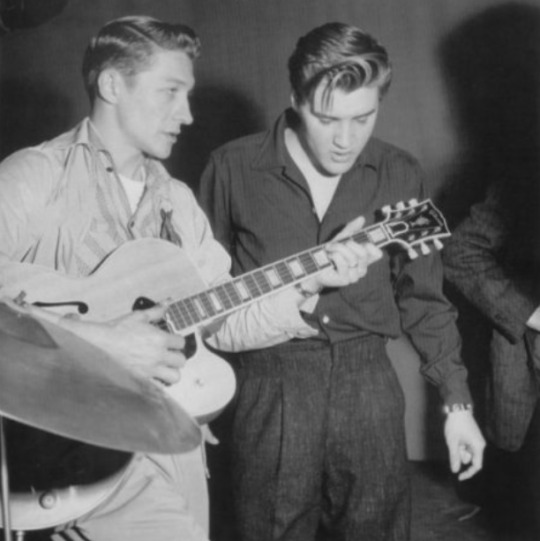
Much of the RCA fifties recordings of Elvis Presley feature the sound of Scotty Moore's L-5. Scotty (with L5) and Elvis rehearse for the Milton Berle show, June 1956.
Scotty's Gibson L-5 was first used to record "Mystery Train" and on most of the subsequent RCA recordings until January of 57 (though it was apparently used on stage at least in Buffalo, NY on April 1, and Toronto on April 2, 1957). Scotty used it extensively with a custom--built Echosonic amplifier by Ray Butts acquired around April of 55 (which allowed the ability to perform live with the signature slap-back echo sound of the recordings).
The Gibson L5 CES features a single rounded cutaway 17" wide bound hollow body, solid carved spruce top, layered tortoise pickguard, single bound f-holes, maple back/sides/neck, 20 fret bound pointed ebony fingerboard with pearl block inlay, adjustable rosewood bridge, model name engraved trapeze tailpiece with chrome insert, multibound blackface peghead with pearl flame/logo inlay, 3 per side tuners, gold hardware, 2 pickups (P90 single coil in 51, Alnico V in 54 and Humbucker in 57) , 2 volume/2 tone controls, 3 position switch. Available in Natural (Scotty's) and Sunburst finish. Mfd. 1951 to date.
Source: http://www.scottymoore.net/54L5CES.html
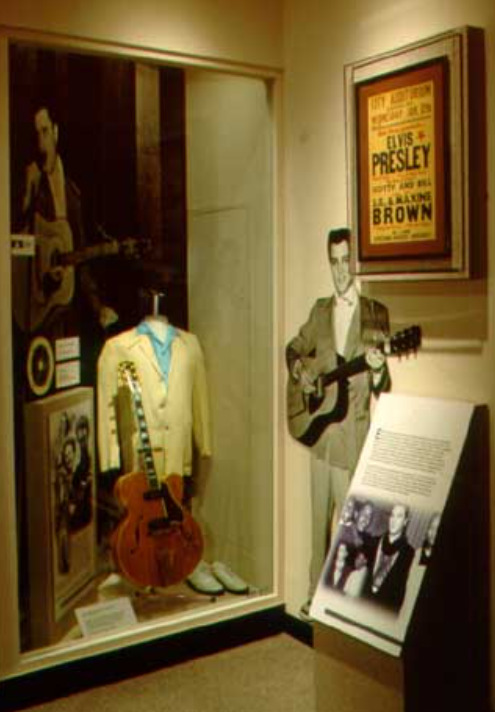
Scotty' L5 The guitar when displayed at the Memphis Rock 'N' Soul Museum.
This guitar was owned by Robert A. Johnson for many years and had been on loan for display at the Memphis Rock 'N' Soul Museum. It was sold in 2004 and expected to be on display at the Elvis-A-Rama museum in Las Vegas, NV. In September of 2005 CKX, Inc (the parent company to EPE, Inc.) announced that it had agreed to acquire the assets of Elvis-A-Rama with the intent of closing it with an overall plan to bring a world class Elvis-themed attraction to the Las Vegas strip. Prior to that though this L5 was sold to a private collector in the UK and is no longer on display. Scotty's L5 was purchased from the UK collector in February of 2005 by Heather Mozart shortly after the auction and along with Scotty's 1956 Super 400, Elvis' 1968 Ebony J200 and many other items remains part of her collection.

Scotty's original 1956 Super 400, 1954 L5 and Elvis' 1968 J200 (Elvis' record awards in rear).
------------------------------------------------------------------------------------------------
🎸 SCOTTY'S GUITARS OVER THE YEARS
MUCH MORE ABOUT ALL SCOOTY MOORE'S GUITARS, HERE (http://www.scottymoore.net/guitars.html) - Website created and managed by James V. Roy for Scotty Moore with the sole intent to help promote the arts and history of American popular music and Scotty's major role in it.
#rock and roll history#scotty moore#guitar hero#scotty moore's guitars#early rock and roll music days#50s rock and roll#vintage#music history#music heroes#Youtube
5 notes
·
View notes
Text
Brown Sound in a Box
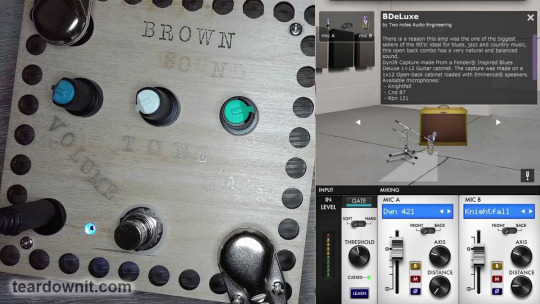
He invented the superstrat, an electric guitar for shredding, a masterful style he pioneered. Of course, it's Eddie Van Halen, one of the world's greatest guitarists. Brown Sound is his signature sound, and we will try to recreate it today.
It all started in California in the first half of the twentieth century. Jazz developed rapidly. The musicians hunted for increasingly complex chords and incredible improvisations.
The usual banjo and mandolin no longer satisfied performing needs, and more and more jazz musicians became interested in the Spanish guitar. It has as many as six strings, at least 19 frets, and quart tuning, setting the mood for serious performance.
But the guitar turned out to be too quiet compared to wind instruments and pianos. Therefore, luthiers began to assemble jazzboxes with a body width of 16 to 19 inches—real mammoths! Pictured is an 18-inch Gibson Super 400.

Jazzboxes had an arched top body, similar to a cello, with f-holes instead of the traditional round ones for guitars. Jazzmen installed thick strings on them, 12 or even 13-gauge. The standard scale length was 25.5 inches, like the future Fender Stratocaster.
In 1921, Gibson began installing truss rods in the necks to withstand such high tension on steel strings. Among other things, this made it possible to create a low string height above the frets and subsequently create thin, fast necks.
Thanks to the truss rod, electric guitar virtuosos were able to improve. Especially since Gibson began producing instruments with a shorter scale of 24 ¾ inches, which is easier to bend. Then, guitars received an electromagnetic pickup and a tube amplifier, and guitarists wanted their sound to be even more loud and overloaded.
The hollow guitar body, critical in the pre-amplification era, became a nuisance: it was susceptible to microphone proximity effects and self-oscillation.
The hollow body also nearly killed sustain, as its essence was to transmit the strings' vibrational energy to the air. As a result, the sound is louder and brighter, but at the same time, it fades faster.

The first experiment in creating an electric guitar without a resonator body involved a lap steel guitar played with a slide. Finally, in 1950, Leo Fender created the Broadcaster, the first true, commercially successful solid-body electric guitar, which soon evolved into our beloved Telecaster.
While Gibson always created guitars as art pieces, Fender instruments were originally conceived as DIY kits. When the frets wear out, you can simply buy a new neck and replace it by removing four screws. There is no need to take your guitar to a luthier and wait for the repair, having no instrument on hand and thus being left with no income if you are a professional musician.
It is worth noting that the Broadcaster's neck had a serious technical flaw—the absence of an anchor. The Telecaster has this drawback eliminated. Vintage Fender guitars require removing the neck to tighten or loosen the truss rod. In contrast, more modern guitars have an Allen key screw in the base of the headstock to adjust the truss rod.
In general, Leo Fender's guitar parts were designed to be removable and attached with screws. This meant that the instrument could be purchased as a modular kit. One can put a humbucker instead of a single-coil and a Floyd Rose instead of a Fender tremolo machine with six self-tappers.

This is exactly what Eddie Van Halen did when creating his Frankenstrat. After all, he was a talented musician, artist, and craftsman. And he came up with the first superstrat in history, a guitar for the ultimate rock and metal.
The Superstrat badly needed super distortion, and we're not talking about the DiMarzio pickup with the same name. Eddie Van Halen's secret "brown sound" resulted from a rather complex sequence of electronic audio signal conversions, which is no longer a secret today.
Happy concertgoers and inspired TV viewers who followed Eddie's every move with bated breath saw a full stack of Marshalls with a Plexi head amp behind him. It was an excellent device, but many people had it.
Van Halen's secret recipe consisted of several ingredients. First, an MXR equalizer was hooked between the guitar and the amp input. It allowed Eddie to fine-tune the gain structure so that some frequency bands were boosted to hard clipping while others passed through the amp relatively unaffected.
Secondly, Variac's variable transformer connected the amplifier to a 120-volt electrical grid. It was powered by a voltage of 90 volts, 75 percent of the required. The tube cathodes were cooler, and the anode voltage was lower than during regular operation of the amplifier. This had a dramatic effect on the nature of the overload.
Thirdly, it was not the cabinets connected to the amplifier's output but the dummy load. This was not a modern reactive electronic load like the Torpedo Captor X, which simulates the impedance of real speakers. It was just a powerful tapped resistor providing the audio with the required amplitude.
Next, the signal went to the pedalboard with the flanger, phaser, and tape delay. From there, it goes to the MOSFET power amplifier H&H V800 and only then to the cabinets. Let's say Eddie implemented an effects loop, which his Marshall Plexi did not have.
Fourth, the cabinets were loaded with a specific combination of different speakers, which Eddie changed from time to time.

Van Halen subsequently moved on to use the Soldano SLO 100. Then he developed his signature 5150 amp with Peavey and the guitar Wolfgang, named after his son. Later, in collaboration with Fender, he created the EVH brand.

I had the EVH 5150 III lunchbox, which is just a great amp. Interestingly enough, the best room sound came not from the Celestion Greenback speaker but from the nameless black 12-inch speaker from the first-generation Fender Mustang II digital combo amp. I got the body and the speaker from this amp without electronics, and they became my favorite closed-back cabinet.

I also had a toy-like EVH 5150 III microstack. If we could add an output jack to an external cabinet, we'd feel some Van Halen vibes, but I didn't like the sound itself.
Unlike the Orange Crush Mini, this EVH product is more of a gimmick than a guitar amp. However, once I came across a YouTube video where this microstack sounded pretty good in an empty concrete room. Which once again proves the impact of the environment on the sound of an electric guitar.
As you can already tell, I like Eddie Van Halen's guitar tone. I don’t so much strive to recreate it as I look for inspiration. That's why building today's pedal is especially interesting for me.
In this diagram, we do not see the usual operational amplifiers. Instead, five JFETs are used here: four in two mu stages and one in a conventional common-source stage. The sixth JFET is responsible for the Millennium bypass. It simply turns off the LED when the gate of the transistor is connected to the ground through the volume control and lights the LED up when it's not.
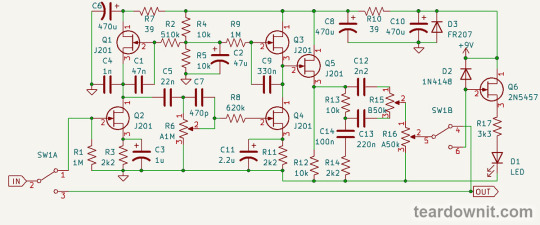
A mu stage is a cascade with an active load. In a simplified way, transistors Q1 and Q3 operation can be represented as current stabilizers. After all, a JFET is a current stabilizer controlled by gate voltage.
Resistors R4 and R5 form a virtual ground—a voltage source equal to half the supply voltage. It is AC grounded by capacitor C2.
We also see power filters. The C8R10C10 U-filter filters the power supply for the entire pedal, and the R7C6—for the first mu stage.
The active load transistor gates Q1 and Q3 are connected to virtual ground through resistors with significant resistances (R2 and R9). Capacitors C1 and C9 are connected between the sources and gates. Therefore, our active loads are not just current stabilizers but also active filters.
R6 is a gain control, and C7 is a treble bypass capacitor. The peculiarities of human hearing are such that when the volume is reduced, the sound seems duller, which is why the volume and gain controls are equipped with such frequency compensation in many devices.
Q5 serves as the output buffer, and R15 is the tone control. In the up position, the pedal outputs more high frequencies, and in the lower position, more low ones.
This is what this distortion sounds like with a Squier Bullet Mustang HH guitar and an Orange Micro Terror amp. I hear hints of the EVH sound in it. Still, it's more reminiscent of the Soldano SLO100 (which Eddie also used until the 5150 was developed).
Despite my stages and good power filters, the distortion is hairy. It must be put in a shielded housing for it to work typically. But even then, this circuit retains a fairly significant noise level.
However, these imperfections do not spoil the sound but make it more alive. If you want no noise, then an EVH 5150 amp is waiting for you to buy it. Fender engineers put a lot of effort into shielding and routing the boards of these high-gain amplifiers so that they are almost completely noise-free.
0 notes
Text
Soft Shoulders




From Top-to-Bottom:
Gibson Super 400 w proportional shoulders on left, Super 400 with soft shoulders on right.
17" Gibson L-5 on left, 18" Super 400 on right.
Soft Shoulders
Proportional Shoulders
When Gibson released the Super 400 in the mid 1930's, it featured what's today known as "soft shoulders." It's a pretty simple, organic development.
The Gibson L-5 came out first...in the 2nd picture you can see how that extra inch changes everything proportionally. That extra inch is expanded in all directions so that everything is proportional. The L-5 legit looks like a little brother to the massive Super 400...despite the fact the L-5 is a battleship in its own right.
Here's the 6' tall Mark Knopfler with a Super 400, an L-5 and a Les Paul in roughly the same position to give you another idea of the size difference...



Either the L-5 or Super 400 is a beast. The L-5 is class personified...everything about it is ideal. It's the shape that defined the entire archtop class. The Super 400 is not as sleek, not as sexy...but it's the beast of the two. That extra size brings with it a sonic depth that even the L-5 struggles to match (the L-5 has better clarity and high end, however).
Because the L-5 came out first, Gibson likey didn't have what's called a plantila (the form for the body shape) specifically made for the 400 yet, so they likely took an L-5's...expanded the lower bout by that extra inch while keeping the upper bout the same as the L-5.
Frankly, I think the soft shoulders look better, and while I've never played a soft shouldered Super 400, I've played the big boy version, and that upper bout digs into your ribs. You get used to it, but still...it's not very comfortable.
It also makes the guitar look like the behemoth it is. The soft shoulder makes the guitar look a little more sleek...the lower bout is usually somewhat obscured by the player's arm, and that size is easier to hide.
Anyways, here's another example of "things I think about."
0 notes
Photo






1937 Gibson Super 400
from http://www.emeraldcityguitars.com/product/1937-gibson-super-400/
18 notes
·
View notes
Photo

Gibson Super 400 China Dragon Bruce Kunkel Custom Masterpiece Archtop Guitar






287 notes
·
View notes
Photo










1961 Gibson Super 400 CES with Factory Varitone Stereo Sunburst | Reverb
11 notes
·
View notes
Text
NXT Fake Rankings, 12/23/2022
Men's singles division - babyfaces
Bron Breakker (NXT men's champion)
Wes Lee (NXT North American champion)
Apollo Crews
Axiom
Odyssey Jones
Xyonn Quinn
Ikemen Jiro
Damon Kemp
Men's singles division - heels
Grayson Waller
Carmelo Hayes
Dijak
Joe Gacy
Von Wagner
JD McDonagh
Scrypts
Charlie Dempsey
Unranked: Dante Chen, Guru Raaj, Hank Walker, Javier Bernal
It's been sixteen months since WWE started dismantling Triple H's vision of NXT, and about five months since Vince McMahon retired and left Triple H in charge of creative. It's telling that almost no one on the roster during the Wednesday Night Wars is still here. I suspect Vince's "up or out" mentality is still in effect, and NXT won't see another long-term mainstay like Johnny Gargano or the Undisputed Era.
On the other hand, I think Solo Sikoa is the only NXT 2.0 performer who has been called up to the main roster. At that rate, it might take a few years to completely turn over the roster again. When Vince was in charge I would have expected Breakker, Jones, and Wagner to get called up by April 2023 whether they were ready or not. As it is, we'll have to wait and see how long Triple H wants everybody to spend in developmental.
Men's tag team division - babyfaces
Kofi Kingston & Xavier Woods (NXT men's tag team champions)
Josh Briggs & Brooks Jensen
Edris Enofe & Malik Blade
Brutus Creed & Julius Creed
Andre Chase & Duke Hudson
Men's tag team division - heels
Pretty Deadly - Elton Prince & Kit Wilson
Tony D'Angelo & Channing Lorenzo
The Dyad (Jagger Reid and Rip Fowler, formerly James Drake and Zack Gibson) and Indus Sher (Veer Mahan and Sanga, formerly Rinku and Saurav) are featured on TV but haven't wrestled in the past month. I'm surprised they haven't done anything with Gallus (Mark Coffey, Joe Coffey, and Wolfgang), who are apparently still employed but you'd never know it from watching the product.
Women's singles division - babyfaces
Roxanne Perez (NXT women's champion)
Alba Fyre
Wendy Choo
Indi Hartwell
Nikkita Lyons
Fallon Henley
Thea Hail
Women's singles division - heels
Cora Jade
Isla Dawn
Zoey Stark
Elektra Lopez
Kiana James
Unranked: Amari Miller, Lyra Valkyria, Sol Ruca
NXT shot itself in the foot by building the entire women's division around "Mandy Rose is super hot" for 400+ days, and then abruptly releasing her for being too super hot. Having her put over Perez is all well and good, but she could have spent the next year or so giving the rub to several other women.
If you don't want your talent posting nude photos on the internet, you need to pay them enough to make it worth their while. And if you don't want to pay them enough, it makes no sense to push them so strongly. So now Mandy's making a shitload of money and living her best life, and all I can say about NXT's women's roster is "Roxanne and a bunch of nobodies who couldn't beat Mandy."
Women's tag team division - babyfaces
Kayden Carter & Katana Chance (NXT women's tag team champions)
Ivy Nile & Tatum Paxley
Women's tag team division - heels
Toxic Attraction - Gigi Dolin & Jacy Jayne
NXT can still only scrape together three women's tag teams, which is still better than Raw and Smackdown put together, which is kind of sad.
No TV or PPV matches in over 30 days: Jagger Reid, Lash Legend, Oro Mensah, Rip Fowler, Trick Williams, Valentina Feroz
No TV, PPV, or streaming matches in over 30 days: Ava Raine, Boa, Cameron Grimes, Ilja Dragunov, Joe Coffey, Mark Coffey, Meiko Satomura, Nathan Frazer, Quincy Elliott, Roderick Strong, Sanga, Sarray, Tyler Bate, Veer Mahan, Wolfgang
Boa has been on the NXT roster since like 2017, and the only reason I know that is because I keep track of things like that for stuff like this. I don't want anybody to lose their job but I am genuinely perplexed how he survived all the releases over the past three years.
Not listed on NXT roster: Aleah James, Blair Davenport, Noam Dar, Stevie Turner
In August, WWE shut down NXT UK and released much of the roster. Everyone else got reassigned to Original Flavor NXT...except these four, for some reason. WWE.com still lists them as "current superstars" but not for any particular show. I can only guess that several of them are awaiting a rebranding like Aoife Valkyrie/Lyra Valkyria and Oliver Carter/Oro Mensah. But Davenport already has a WWE-owned name, and I haven't heard of her being injured, so I don't know what's up with her.
Inactive
Tiffany Stratton (head - unspecified injury)
Yulisa Leon (right knee - unspecified ligament tear)
I wouldn't be surprised if there are more people sidelined on the NXT roster, but reliable information has gotten harder to find as the brand has become less relevant.
4 notes
·
View notes
Text




IM FUCKIN DYING OVER THIS CUSTOM SUPER 400 SOMEONES SELLING
0 notes
Photo
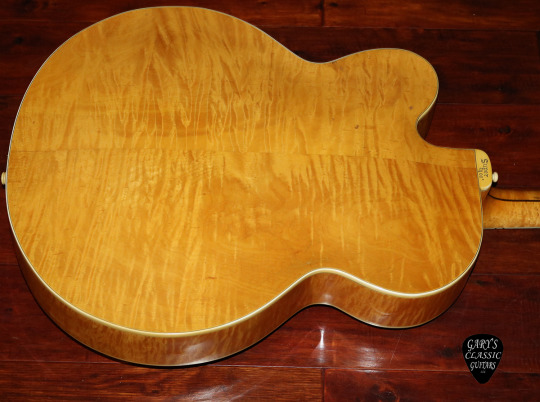
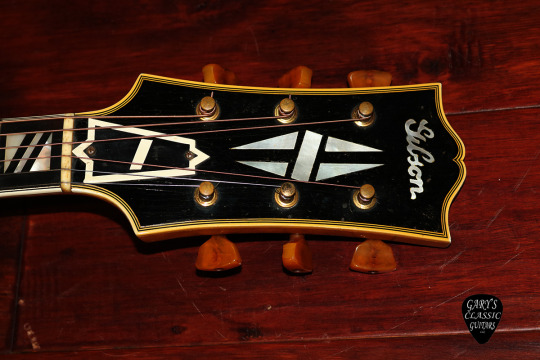

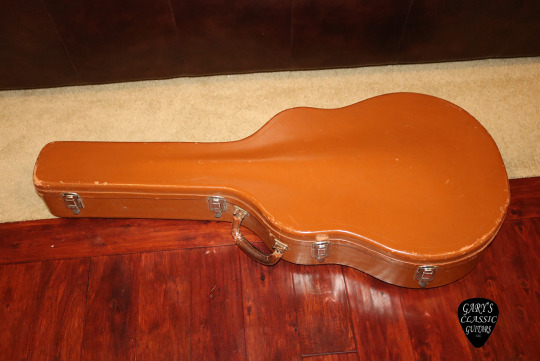
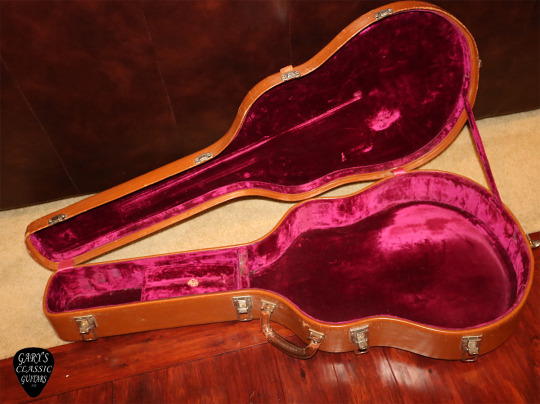


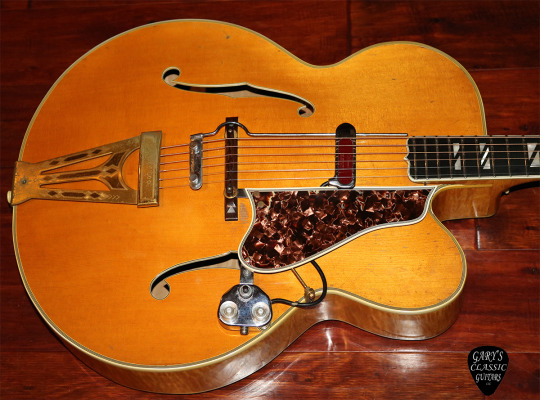

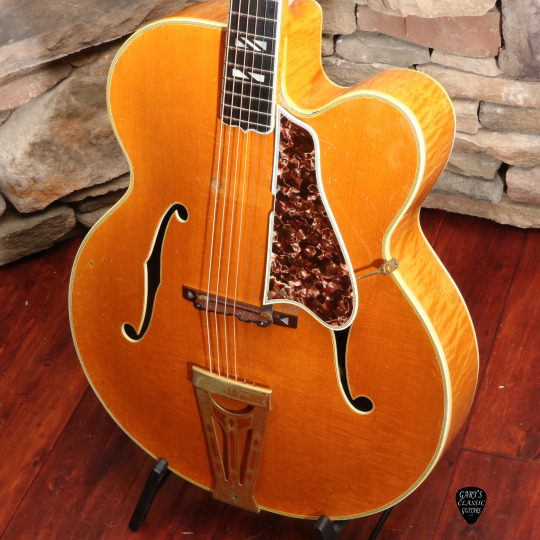
1942 Gibson Super 400 Premier, "Cutaway", Very Rare Blonde finish, Top of the line Model, Gold hardware, Original Kluson tuners with beautiful original Catalin tips, Super 400 engraved heel cap & tailpiece, Script logo, Bound Ebony fingerboard with split block Pearl inlays, Original Brazilian bridge with Pearl inlays, Gorgeous flamed Maple back, sides & neck, Fabulous sounding, Has a DeArmond floating pickup that was installed which we will provide, Smooth playing instrument, Very special instrument, Excellent condition, Clean Original leather hard case with plush lined interior and cove
#Gibson Super 400#Gibson#vintage archtop guitar#vintage acoustic guitar#vintage guitar#vintage guitars
45 notes
·
View notes
Text

Little Jimmy Dickens playing his 1937 Gibson Super 400 with a custom double pick guard.
40 notes
·
View notes
Photo

1940 Gibson Super 400
25 notes
·
View notes
Text
youtube
youtube
Just some random bullshit today.
What I like about the second vid is that it gives good context for just how loud an acoustic Super 400 is. I've talked about this dynamic before...old archtops were meant to cut through big bands without any amplification. Old horses like the 18" Super 400 and the 19" Stromberg Master 400 ruled the roosts because of their sheer physical advantage...more size = more volume and projection*.
*there are ways to mitigate this with bracing and construction methods, but generally speaking...the bigger, the beefier.
Over YouTube, it's almost impossible to get an idea of this volume though. But now that we have a baseline of a Super 400CES (the pickups being built into the top reduce acoustic volume dramatically) going through a Fender Princeton with the volume set at 3.5, we can get an idea.
I had a Princeton (sold a couple years ago) and at 3.5 on the volume knob, that's good enough to drown out a TV in your living room. The acoustic Super 400 is being played lightly, and more than hangs with the amplified cousin. If the guy on the right actually dug in with some effort? He'd have drowned out the amp to the point the guy on the left would have to turn up to keep up.
Anyways, it's pretty obvious why you don't still see many Super 400's around...the electric variant had so much easier controls over dynamics and volume, was easier to get around, and...well shit, if it's this much more convenient on an 18" behemoth, it's probably even more convenient on much smaller guitars.
Which is totally true, and the reason that my main guitar for playing out isn't my beloved Nickerson archtop, rather my trusty Gibson 335. But the gain in convenience and control comes at a cost...
youtube
youtube
It's not bad or worse or anything like that...just that there's an organic "fatness" and "roundness" you lose with thin hollowbodies and solid bodied gutiars. Yes, feedback is harder to control, mistakes are amplified, they're bulky and fragile...but that sound with all that air being pushed around is impossible to recreate without studio tricks. The feel of the guitar vibrating against your body is legitimately impossible to recreate.
I don't really have a point to make here, aside from archtops are awesome and I love playing them. The all-acoustic ones are even less practical...but they're more fun to play. Fixed pickups deaden the acoustic sound, but a floater doesn't impact it at all...which is why I love floaters.

Best of both worlds...for a very specific, narrow world...where very few listening or watching will notice or care. But that's not the point.
I'd love to own and play a Super 400...I likely never will. If you're talking about a baseline pricetag of about $10,000, there are a lot better options. It's not even really the price tag that turns me off as much as the realization that my right arm would be numb if I played it more than 45 minutes straight because of how deep it is. What good is heroin if it won't let me shoot it directly into my veins?
But if you want the platonic ideal of jazz guitar tone, that guitar's gotta be big, deep and hollow regardless of what kind of pickup it's got on there. The ES-175 and L-5 might be Gibson's highest profile jazz guitars (as much as for their practicality as who played them), but the Super 400 is still considered the king.
I'm keeping the Keith Jarrett thing at the top for no good reason.
0 notes
Photo





1948 Gibson Super 400
from https://cartervintage.com
11 notes
·
View notes

